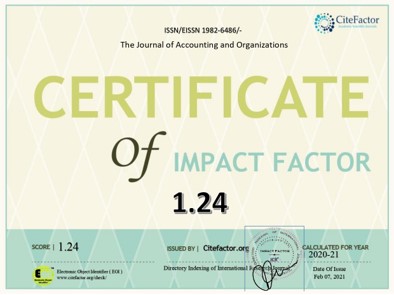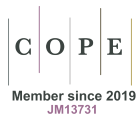Returns and stock prices forecast from accounting data conditioned on the firm life cycle
DOI:
https://doi.org/10.11606/issn.1982-6486.rco.2019.160869Keywords:
Accounting model, Expected return and price, Stages of the firm life cycle, Firm life cycleAbstract
This article investigates the effect of firm's life cycle stages on the determination of expected returns and prices of Brazilian stocks based on the valuation accounting model developed by Lyle, Callen and Elliott (2013). In order to define the life cycle stages, we adopted the methodology developed by Dickinson (2011), using a parsimonious proxy for firm level, structured from the cash flow demonstration with strong economic theories adherence. Data were collected in the Bloomberg, Quantum and NEFIN/FEA/USP databases, the information was generated on the firm's level. The results suggest that the model for the analyzed period does not have returns predictions capacity in Brazil, given the non-significance of the variables even considering the assets in different stages of the firm life cycle, however for the prices’ forecasts there was considerable explanatory power, especially in the maturity stage.
Downloads
References
Formation: A Study in the Brazilian Market. Contaduría y Administración, 60(4): 874–92. DOI: https://doi.
org/10.1016/j.cya.2015.07.010.
Antônio, R. M., Ambrozini, L. C. S., Gatsios, R. C., & Magnani, V. M. (2017). Analysts' Consensus and Target
Price Accuracy: A Study in Latin America. Brazilian Administration Review – BAR, 14(4), 1–19. DOI: http://
dx.doi.org/10.1590/1807-7692bar2017170036.
Antônio, R. M., Lima, F. G., dos Santos, R. B., & Rathke, A. A. T. (2019). Use of Derivatives and Analysts’
Forecasts: New Evidence from Non‐financial Brazilian Companies. Australian Accounting Review, 29(1),
220–234. DOI: https://doi.org/10.1111/auar.12268.
Callen, J. L. (2016). Accounting Valuation and Cost of Equity Capital Dynamics. Abacus, 52(1): 5-25. DOI: http://
dx.doi.org/10.1111/abac.12070.
Collins, D., Maydew, E., & Weiss, I. (1997). Changes in the value-relevance of earnings and book values over the
past forty years. Journal of Accounting and Economics, 24(1): 39–67. DOI: https://doi.org/10.1016/S0165-
4101(97)00015-3.
Costa, W. B., Macedo, M. A. S., Yokoyama, K. Y., & Almeida, J. E. F. (2017). Análise dos Estágios de Ciclo de
Vida de Companhias Abertas no Brasil: Um Estudo com Base em Variáveis Contábil-Financeiras. Brazilian
Business Review – BBR, 14(3): 304-320. DOI: http://dx.doi.org/10.15728/bbr.2017.14.3.3.
DeAngelo, H., DeAngelo, L., & Stulz, R. M. (2006). Dividend Policy and the Earned/Contributed Capital Mix: A
Test of the Lifecycle Theory. Journal of Financial Economics, 81(2): 227-254. DOI: http://dx.doi.org/10.2139/
ssrn.766086.
Dickinson, V. (2011). Cash Flow Patterns as a Proxy for Firm Life Cycle. The Accounting Review, 86(6): 1969–
1994. DOI: https://doi.org/10.2308/accr-10130.
Dickinson, V., Kassa, H., & Schaberl, P. D. (2018). What information matters to investors at different stages of a
firm's life cycle? Advances in Accounting, 42, 22-33. DOI: https://doi.org/10.1016/j.adiac.2018.07.002.
Evans, M. E., Njoroge, K., & Yong, K. O. (2017). An Examination of the Statistical Significance and Economic
Relevance of Profitability and Earnings Forecasts from Models and Analysts. Contemporary Accounting
Research, 34(3): 1453–1488. DOI: https://doi.org/10.1111/1911-3846.12307.
Fama, E., & French, K. (1993). Common risk factors in the returns on stocks and bonds. Journal of Financial
Economics, 33(1): 3–56. DOI: https://doi.org/10.1016/0304-405X(93)90023-5.
Fama, E., & Macbeth, J. D. (1973). Risk, return, and equilibrium: Empirical tests. Journal of Political Economy,
81(3): 607–636. Disponível em: http://www.jstor.org/stable/1831028.
Faff, R., Kwok, W. C., Podolski, E. J., & Wong, G. (2016). Do corporate policies follow a life-cycle? Journal of
Banking & Finance, 69, 95-107. DOI: http://dx.doi.org/10.2139/ssrn.2610483.
Feltham, G., & Ohlson, J. A. (1999). Residual earnings valuation with risk and stochastic interest rates. The
Accounting Review, 74(2): 165–183. Disponível em: www.jstor.org/stable/248579.
Feltham, G., & Ohlson, J. A. (1995). Valuation and clean surplus accounting for operating and financial activities.
Contemporary Accounting Research, 11(2): 689-731. DOI: https://doi.org/10.1111/j.1911-3846.1995.
tb00462.x.
Garcia, R., Mantilla-García, D., & Martellini, D. (2014). A model-free measure of aggregate idiosyncratic volatility
and the prediction of market returns. Journal of Financial and Quantitative Analysis, 49(5–6): 1133–1165.
DOI: https://doi.org/10.1017/S0022109014000489.
Gatsios, R. C., & Lima, F. G. (2014). Forecast Bias of Estimates of Market Analysts in the Brazilian Capital
Market: Impact of the IFRS Adoption. Business and Management Review, 3(11), 1–6.
Goyal, A., & Santa-Clara, P. (2003). Idiosyncratic Risk Matters! Journal of Finance, 58(3): 975-1008. Disponível
em: www.jstor.org/stable/3094569.
Hasan, M. M., & Cheung, A. W-K. (2018). Organization capital and firm life cycle. Journal of Corporate Finance,
48, 556-578. Disponível em: https://ssrn.com/abstract=2483834.
Habib, A., & Hasan, M. M. (2019). Corporate life cycle research in accounting, finance and corporate governance:
A survey, and directions for future research. International Review of Financial Analysis, 69, 188-201. DOI:
https://doi.org/10.1016/j.irfa.2018.12.004.
Hasan, M. M., Hossain, M., Cheung, A. W-K, & Habib, A. (2015). Corporate life cycle and cost of equity
capital. Journal of Contemporary Accounting & Economics, 11(1): 46-60. DOI: https://doi.org/10.1016/j.
jcae.2014.12.002.
Koh, S., Durand, R. B., Dai, L., & Chang, M. (2015). Financial distress: Lifecycle and corporate restructuring.
Journal of Corporate Finance, 33, 19-33. DOI: https://doi.org/10.1016/j.jcorpfin.2015.04.004.
Kothari, S. P. (2001). Capital markets research in accounting. Journal of Accounting and Economics, 31(1-3):
105–231. DOI: https://doi.org/10.1016/S0165-4101(01)00030-1.
Lima, A. S., Carvalho, E. V. A., Paulo, E., & Girão, L. F. A. P. (2015). Estágios do Ciclo de Vida e Qualidade das
Informações Contábeis no Brasil. Revista de Administração Contemporânea, 19(3), 398. DOI: http://dx.doi.
org/10.1590/1982-7849rac20151711.
Lyle, M. R., Callen, J. L., & Elliott, R. J. (2013). Dynamic risk, accounting-based valuation and firm fundamentals.
Review of Accouning Studies, 18(4): 899–929. DOI: https://doi.org/10.1007/s11142-013-9227-x.
Nekrasov, A., & Shroff, P. (2009). Fundamentals-based risk measurement in valuation. The Accounting Review,
84(6): 1983-2011. DOI: http://dx.doi.org/10.2139/ssrn.913067.
Ohlson, J. A. (1995). Earnings, book values, and dividends in equity valuation. Contemporary Accounting
Research, 11(2): 661–687. DOI: https://doi.org/10.1111/j.1911-3846.1995.tb00461.x.
Saito, R., Villalobos, S., & Benettui, C. (2008). Qualidade das Projeções dos Analistas Sell side: Evidências
Empíricas do Mercado Brasileiro. Revista de Administração da USP, 43(4): 356–369.
Schaberl, P. (2016). Beyond accounting and back: An empirical examination of the relative relevance of earnings and “other” information. Advances in Accounting, 35, 98–113. DOI: https://doi.org/10.1016/j.adiac.2016.08.004.
Vorst, P., & Yohn, T. (2018). Life cycle models and forecasting profitability and growth. The Accounting Review,
93(6), 357-381. DOI: https://doi.org/10.2308/accr-52091.
Downloads
Published
Issue
Section
License
The RCO adopts the Free Open Access policy, under the standard Creative Commons agreement (CC BY-NC-ND 4.0). The agreement provides that:
- Submission of text authorizes its publication and implies commitment that the same material is not being submitted to another journal. The original is considered definitive.
- Authors retain the copyright and grant the journal the right of first publication, with the work simultaneously licensed under the Creative Commons Attribution License which allows the sharing of the work with acknowledgment of authorship and initial publication in this journal.
- Authors are authorized to take additional contracts separately, for non-exclusive distribution of the version of the work published in this journal (e.g. publish in an institutional repository or as a book chapter), with necessary recognition of authorship and initial publication in this journal.
- Authors are allowed and encouraged to publish and distribute their work online (e.g. in institutional repositories or on their personal page) before or during the editorial process, as this can generate productive changes as well as increase the impact and citation of published work (See The Effect of Free Access).
- The journal does not pay copyright to the authors of the published texts.
- The journal's copyright holder, except those already agreed in the Free Open Access Agreement (CC BY-NC-ND 4.0), is the Accounting Department of the Faculty of Economics, Administration and Accounting of Ribeirão Preto of the University of São Paulo.
No submission or publication fees are charged.
Up to 4 authors per article are accepted. Exceptionally duly justified cases may be reviewed by the Executive Committee of the RCO. Exceptional cases are considered as: multi-institutional projects; manuscripts resulting from the collaboration of research groups; or involving large teams for evidence collection, construction of primary data, and comparative experiments.
It is recommended that the authorship be ordered by contribution of each of the individuals listed as authors, especially in the design and planning of the research project, in obtaining or analyzing and interpreting data, and writing. Authors must declare the actual contributions of each author, filling the letter to the editor, at the beginning of the submission, taking responsibility for the information given.
Authors are allowed to change throughout the evaluation process and prior to the publication of the manuscript. The Authors should indicate the composition and final order of authorship in the document signed by all those involved when accepted for publication. If the composition and authoring order is different than previously reported in the system, all previously listed authors should be in agreement.
In the case of identification of authorship without merit or contribution (ghost, guest or gift authorship), the RCO follows the procedure recommended by COPE.







